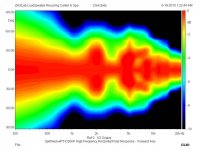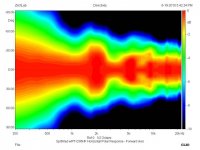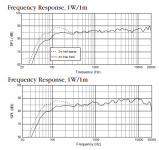I think it was a well meant suggestion perhaps framed rather bluntly. Well meant, because despite the necessarily chaotic nature of the discussion due to the format and the hugely disparate backgrounds of the participants, it's probably the best discussion you will get regarding speaker directivity and it's psychoacoustic possibilities with regard to sound reproduction in small rooms.I thought your suggestion that I read through 4,500+ posts was disingenuous.
There are a very large number of useful references sprinkled through the thread. I think you underestimate the difficulty of studying sound reproduction in small rooms until you've read a good chunk of this thread. Or, have read Toole's book and perhaps also Moore's An Introduction to the Psychology of Hearing.
[....]
Please note the title of this thread. It's "Geddes on Waveguides" and it's hardly neutral content in context of DIY speaker building and there are practitioners who strongly disagree with much of it for a multitude of reasons, most of which I think are not necessarily well thought out because, although there is not a lot of the kind of research you think should exist, there has been a lot of psychoacoustic research done in the last 150 years some of which is applicable to sound reproduction in small rooms, and from which Geddes has gleaned very useful insights.Seems to me, if you had a few really knock-out boffo references from a peer-reviewed or otherwise non-commercial or neutral source, you would have tooted them from the rooftop, instead of providing the kind of rude "get the heck out of town by sundown" response that you provided. And feeling the urge to post it TWICE.
No, you're not going to get knock-out boffo references. They don't exist. Although, you might find some useful, deliberately limited ones on Geddes's website.
There is no point in deploring the undeveloped nature of the research regarding the psychoacoustic effect of speaker directionality as a criticism of what we talk about here. We got lemons and we're making lemonade. Or as someone said a few posts back, we're discussing possible best practices in the light of current knowledge.
Great results by any standard, John !
Would like to see more of this current work of yours - maybe on an own thread ? - some pix and some comments, whatever ...
Michael
All very flattering and I will be more than happy to discuss the design objectives and approach for the Note when the time is right. I don't know that I would really want to start an endless thread on it though. I think I would rather simply define my objectives and explain why I did what I did on my web site. There is noting magical in the design. It's just executed without trying to cut corners.
Many of the most respected scientists of the 19th century would be in the fullest agreement with your thinking.
The data and measurements in this thread is not 19th century.
No, I have never heard a Geddes speaker. I regret that and I would gladly travel within reason to hear them in the Toronto region. Help me find some and in a good listening environment.
But I have heard a great many two-way systems. In fact, when I was at the famous Bell Labs in Murray Hill, New Jersey, two-way KLH-6s were the lab standard speaker for the scientists in my division ("Human Information Processing and Music," if I recall).
Ah, 1967 was a wonderful year at Bell.
Who cares how many great two-way systems you have heard! What is your beef with the thread?
Either you want to learn more about waveguide designs or you don't. If you do not want to learn more then there isnt any real point in reading this thread or posting comments looking for a fight (which I have no problem fighting, it replaces the days at the El Mocambo in Toronto in the 80s when it was real fights
There is a reason some of the best speakers have waveguides or similar around tweeters.
Last edited:
While it's an appealing notion to do a blind ABX test for directivity and how it sounds, in practice it would be very hard. You'd need two speakers that were identical in every way except for directivity and I don't know how you would go about building such speakers. There would be other differences besides directivity. You could say you like speaker A better than speaker B but you'd never know for sure that directivity was the reason.
Nah, trivial:While it's an appealing notion to do a blind ABX test for directivity and how it sounds, in practice it would be very hard. You'd need two speakers that were identical in every way except for directivity and I don't know how you would go about building such speakers.
http://www.jblpro.com/catalog/support/getfile.aspx?doctype=3&docid=1080
http://www.jblpro.com/catalog/support/getfile.aspx?doctype=3&docid=1079
Also, it's easy enough to assess the effect of directivity in a given listening space by varying the toe-in of a pair of moderate dispersion constant directivity speakers. With the requisite linkage, it could be adjusted in real time by the listener....
Attachments
Last edited:
Nah, trivial:
http://www.jblpro.com/catalog/support/getfile.aspx?doctype=3&docid=1080
http://www.jblpro.com/catalog/support/getfile.aspx?doctype=3&docid=1079
Also, it's easy enough to assess the effect of directivity in a given listening space by varying the toe-in of a pair of moderate dispersion constant directivity speakers. With the requisite linkage, it could be adjusted in real time by the listener....
Hey Zilchlab, now 1000 fingers are itching to type that you don't know what you are talking about.
But not one finger to try it.
Hey Zilchlab, now 1000 fingers are itching to type that you don't know what you are talking about. But not one finger to try it.
I've tried it. I use it.
Sheldon
I've tried it. I use it.
Sheldon
Pray tell us your experience.
(I'm busy this afternoon watching "Organ Blaster" on the spectrum analyzer - see my later post on Ruffatti Organ thread)
Last edited:
Pray tell us your experience.
Not sure what you want to know. But I have Unity's, which are 60 degree (total) and about 16", and crossed to a 15" woofer at about 350Hz. The best, and most stable image over the widest area is when they are toed in to cross well in front of the listening position. Don't have the exact angle handy, but I think it's something less than 45 degrees. Also sound is cleanest (or clearest, for lack of a more precise term) toed in as such. I can provide more details on the room if interest extends beyond argumentation.
Sheldon
Dunno; kinda looks like dipole directivity vs. waveguide directivity in the same package to me....Hey Zilchlab, now 1000 fingers are itching to type that you don't know what you are talking about.
But not one finger to try it.
You gotta normalize them, is all.Thanks for making my point Zilch.If we blind test those two speakers you linked and prefer one over the other, is it because of different directivity or could it be this?
Open in separate tabs and toggle between the two:
http://www.diyaudio.com/forums/atta...d1278525595-geddes-waveguides-sw26a_hpmn2.jpg
http://www.diyaudio.com/forums/atta...9d1278525595-geddes-waveguides-sw95_hpmn2.jpg
Close enough to answer the question?
http://www.diyaudio.com/forums/atta...-waveguides-orion-directivity-per-geddes-.jpg
http://www.diyaudio.com/forums/atta...waveguides-nathan-directivity-per-geddes-.jpg
Talk to Olive and get it done.
[There's probably a master's thesis in it for some acoustical engineering student....
 ]
]
Last edited:
I am certain that none of you scientifically sophisticated and erudite posters would be devoting such energy and warmth to this discussion without trustworthy evidence of human perception underlying your strongly held assertions.
You know... blind or double-blind tests, behind-the-curtain loudspeakers, ABBA comparisons, a little stats, quantitative judgments of flute placements along the front wall, subjective ratings of the soundstage.....
Perhaps links to this evidence could be provided?
Or perhaps not.
is it fair of me to ask for evidence?
When Floyd Toole was a researcher at the Nat Res. Council of Canada, I read a fair amount of his work (and I was on a Board of Directors of the NRC in a related division). Truly impressive efforts for an engineer working as a psychologist. I'd say he made a far better psychologist than I would make a bridge designer.
There are precisely 2 questions here.
1. the desire for links that have double-blind studies on the perception of more directive designs (at least at higher freq.s), and
2. if such a request (#1) is fair.
Answers:
1. NO.
2. YES.
Bentoronto does this satisfy your curiosity?
Not sure what you want to know. But I have Unity's, which are 60 degree (total) and about 16", and crossed to a 15" woofer at about 350Hz. The best, and most stable image over the widest area is when they are toed in to cross well in front of the listening position. Don't have the exact angle handy, but I think it's something less than 45 degrees. Also sound is cleanest (or clearest, for lack of a more precise term) toed in as such. I can provide more details on the room if interest extends beyond argumentation.
Sheldon
Nooooo argumentation at all. Thanks for your clear post.
My take is that your experience agrees with the traditional POV: you toe-in excessively cross-eyed and that compensates for the added distance from the "far" side and related effects.
This may or may not correspond to a Geddes recommendation (I'd be the last to offer an opinion) but it does highlight the "experimental cross test" of distance/angle versus near-wall reflection which are issues in this thread.
Perhaps wiser others could parse it. And provide more evidence.
Hey ScottG - I owe you a beer. Your smarts are apparent.
The level of the far side reflection will be similar to what you might expect from nearside in a non-toed in CD setup, however, there will be a greater delay. The greater the delay, the less it interferes with our initial perceptive cues. It becomes ambience rather than acting as an interference pattern in our hearing summation.
Hope that makes as much sense in the reader's mind as mine.
Hope that makes as much sense in the reader's mind as mine.
The level of the far side reflection will be similar to what you might expect from nearside in a non-toed in CD setup, however, there will be a greater delay. The greater the delay, the less it interferes with our initial perceptive cues. It becomes ambience rather than acting as an interference pattern in our hearing summation.
Hope that makes as much sense in the reader's mind as mine.
Thank you for "parsing."
Do you mean "far side direct sound" rather than "far side reflection"?
You could say you like speaker A better than speaker B but you'd never know for sure that directivity was the reason.
Agree that might be difficult. Take the Meyer Sound CQ series, for example. The CQ-1 sounds smoother than the CQ-2. Is that directivity, or crossover work or both? Ditto the UPA-1 UPA-2.
Thank you for "parsing."
Do you mean "far side direct sound" rather than "far side reflection"?
I'm talking about the reflection from the left hand wall as excited by the right hand speaker and vice versa. This is part of the reason for the toe in- it increases the relative level of the further reflection for the sake of reducing the near-wall (right wall, right speaker) reflection.
The benefit of a consistent SPL for each speaker as one moves around the seating area is the primary driver for this toe-in scheme (at least it's the reason cited most often) but I thought we were talking about my first point.
I wasn't paying much attention to that when I did it, but the filters could not have been much different for me to accomplish it so easily. I may have the files, if it's an issue.Agree that might be difficult. Take the Meyer Sound CQ series, for example. The CQ-1 sounds smoother than the CQ-2. Is that directivity, or crossover work or both? Ditto the UPA-1 UPA-2.
JBL's highpasses are substantially more different than anything I might have done experimentally to acquire the directivity data:
http://www.jblproservice.com/pdf/AE Series Compact Models/AC1826-WH.pdf
http://www.jblproservice.com/pdf/AE Series Compact Models/AC1895-WH.pdf
- Home
- Loudspeakers
- Multi-Way
- Geddes on Waveguides



